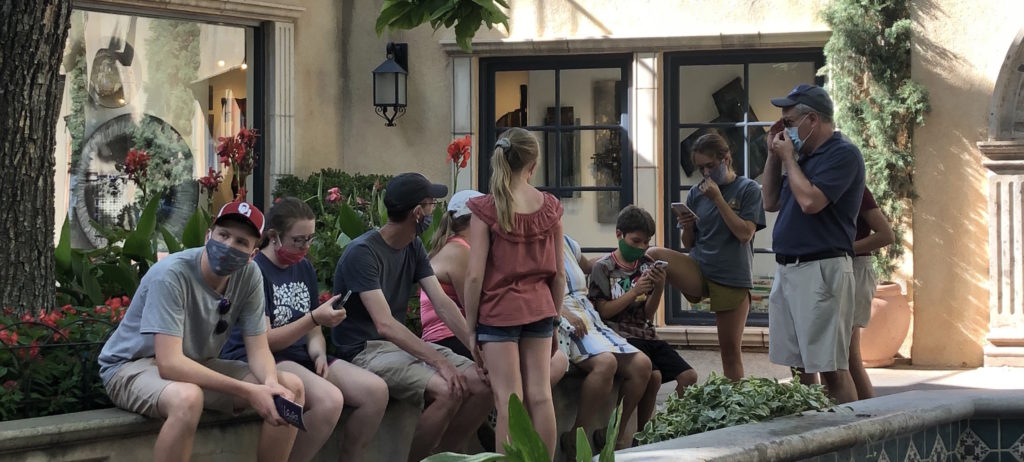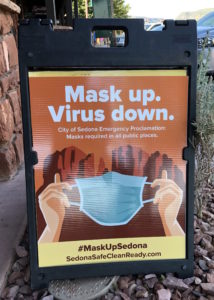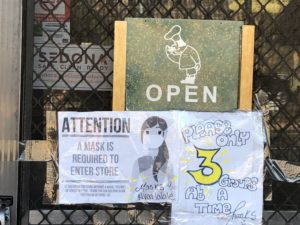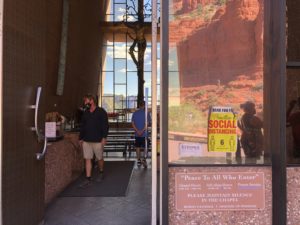Frances Julia Riemer
Northern Arizona University
I live in Sedona, Arizona, a popular tourist destination in the American Southwest. An average of three million visitors are drawn to Sedona each year by the Mogollon Rim, an escarpment of red sandstone buttes and canyons. Tourists come to hike, jeep, buy crystals, and commune in what the city’s tourism industry has successful billed as energy “vortexes.” Our resident population is less than 11,000, and the ever-increasing number of tourists in town has become both problematic and political. Those of us who study tourism and those of us who live in tourist sites know that the host/guest relationship in tourism has been fraught with challenges and animosities. We locals in Sedona regularly complain on social media about long lines of bumper-to-bumper traffic, litter, and irresponsible behavior. Now, during COVID19, we also complain about tourists not wearing masks.

Anecdotal evidence suggests that we are not alone. Way back in February, Thailand’s Health Minister, Anutin Charnvirakul, complained to the media about Western tourists not wearing masks. “They don’t care about the big picture and these tourists are in the country. We’re giving the masks to them and they still refuse.” In the United States, tourist resistance to mask wearing has been reported more recently in Moab, Utah; Santa Fe, New Mexico; St. Augustine, Florida; the Lake of the Ozarks, Missouri; and Las Vegas, Nevada. We know that masks have been weaponized here in the US, but my interest in tourism also makes me wonder: how do tourism’s imaginaries further complicate the wearing of masks during the pandemic?
Imaginaries, the “intangibles, vague or specific mental concepts whose exact nature and boundaries are hard to nail down,” have provided a way of studying our travels (Gravari-Barbas & Graburn 2016, 3). Imaginaries are mutable and frequently contested. My colleagues and I explore many of the ways these contests may play out in Front and Back Stage at the Tourism Performance: Imaginaries and Bucket List Venues. Chapter authors document the construction, negotiation, and contestation of travel imaginaries—markets in Agra and Fez, beaches in Mexico and the Caribbean, Mayan ruins of Tulum, safari in Botswana, the Festival in the Desert outside Timbuktu, backpacking treks in Nepal, Kichwa cultural displays in Ecuador, and Komodo dragon walks in Indonesia—by the state, the private sector, intermediaries, tourists, and locals. The ethnographies also trouble dream destinations by revealing the enactment of power in these global contact zones.
 The pandemic brings together two global flows—tourism and virus—in destinations like Sedona. Yet certain public health measures that respond to the global spread of COVID-19 disrupt well-established travel imaginaries. As the local anti-mask contingent has argued, requiring masks would mar Sedona’s pristine natural beauty, and discourage health-conscious tourists from visiting the area. Masks (like social distancing) have become partisan symbols in the US, and as Arizona has emerged as a current virus hotspot, the Republican governor turned over COVID-19 policies to local municipalities. Against significant opposition, on June 25, Sedona’s Mayor ordered the wearing of masks in public places when distancing is “difficult or impossible.” The turnaround in practice has been astounding. In post-mandate visits to popular Sedona tourist attractions, everyone–tourists, guards, cashiers–wore a mask in and outside, and nearly all shops posted signs, many cleverly worded, on the mask requirement.
The pandemic brings together two global flows—tourism and virus—in destinations like Sedona. Yet certain public health measures that respond to the global spread of COVID-19 disrupt well-established travel imaginaries. As the local anti-mask contingent has argued, requiring masks would mar Sedona’s pristine natural beauty, and discourage health-conscious tourists from visiting the area. Masks (like social distancing) have become partisan symbols in the US, and as Arizona has emerged as a current virus hotspot, the Republican governor turned over COVID-19 policies to local municipalities. Against significant opposition, on June 25, Sedona’s Mayor ordered the wearing of masks in public places when distancing is “difficult or impossible.” The turnaround in practice has been astounding. In post-mandate visits to popular Sedona tourist attractions, everyone–tourists, guards, cashiers–wore a mask in and outside, and nearly all shops posted signs, many cleverly worded, on the mask requirement.
COVID-19 has revealed the importance of strong leadership that privileges the health of our communities over private sector profits. It’s not a big leap to apply that lesson to tourism as well. In Front and Back Stage of Tourism Performance, chapter authors relate stories of government actions that reflect and support the tourism industry, often to the detriment of local vendors and other community members. In Sedona, the Mayor’s recent action provides a counter example, one that prioritizes the health and safety of both hosts and guests.
I optimistically hope that this moment of re-boot, with international travel on hold, will be an opportunity to rethink the ways we host and practice tourism. In the old normal, “tourists go home” graffiti accompanied complaints about over-tourism. Now COVID-19 adds another, potentially fatal layer to our tourism discourse. But it also lays bare the contestation of established imaginaries, and perhaps it provides an opportunity to rethink the role of local communities and local leadership in setting expectations, priorities, and parameters for tourism.






